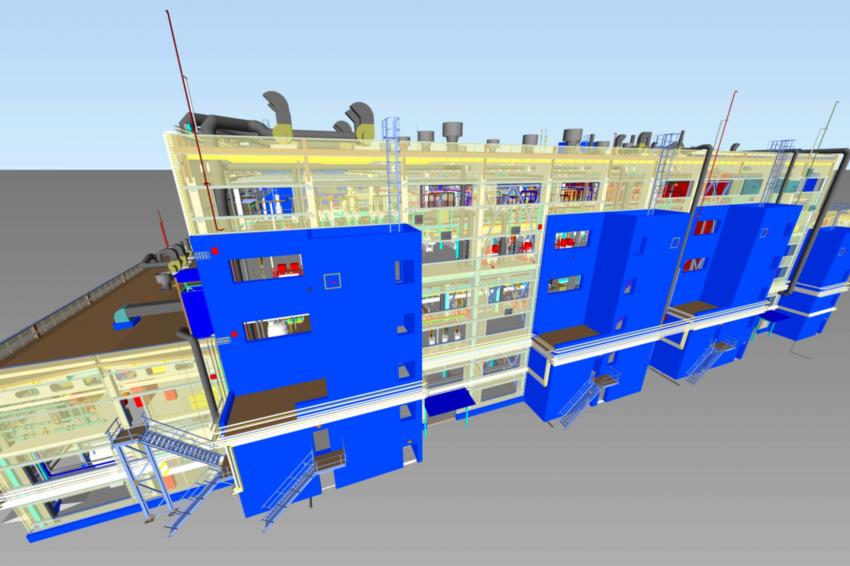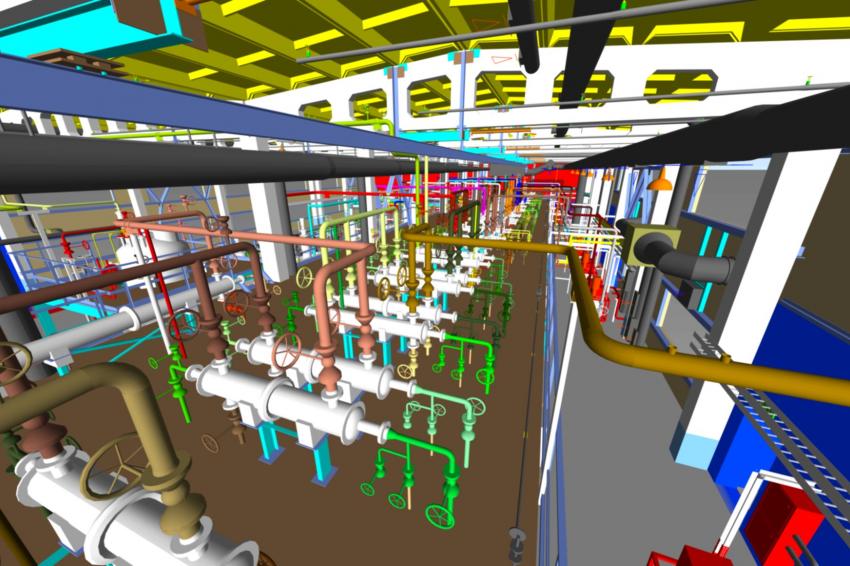BIM Strategy on Russia’s First Methylchlorosilane Production Facility
Bentley’s Interoperable Software Reduces Design Time by 25 Percent
The Complex for Industrial Production project sought to meet Russias domestic demands for methylchlorosilane, a key raw material for space, aviation, and hi-tech mechanical engineering complexes operating in Russian and Commonwealth of Independent States (CIS) countries. Situated within the city limits of Kazan, Russia, a 9.8 billion Russian Rubles complex is being built to be the first of its kind for the Russian Federation.
Comprising 18 new buildings, the project involves renovating an obsolete rubber plant as well as connecting to existing utility and auxiliary energy networks. Soyuzhimpromproekt, a provider of complex design and engineering services for chemical and petrochemical facility construction, was retained to design the entire facility to be fully operational within a three-year period. This complex project required multi-disciplined engineering processes to meet the tight deadlines, and demanded the highest standards of environmental sustainability.
Soyuzhimpromproekt relied on Bentley’s Building Information Modeling (BIM) modeling and analysis applications to implement an integrated design approach. ProjectWise, OpenPlant, and a host of other applications collectively facilitated a collaborative design process allowing multiple disciplines to work in parallel, cutting design time and project costs. This technology enabled Soyuzhimpromproekt to reduce the amount of environmental contaminants and minimize waste products to be disposed or recycled.
BIM Workflow Accelerates Design
“Different project elements such as processing, piping, mechanical equipment, steel structures, cabling, and electrical equipment were collected into one informative model using i-model Composition Server,” explained Sergei Krashakov, head of design at Soyuzhimpromproekt. The project workflow was structured through ProjectWise. AutoPlant was used as the foundation for modeling the piping and equipment, and ProStructures to accommodate civil design. Integrating other Bentley applications helped the project team develop a unified database of materials and equipment, and automated the generation of specifications and estimates.
Using AutoPlant and OpenPlant, the team designed and located over 400 new and existing equipment units and managed more than 800 pieces of piping extending 15 km. ProStructures, Bentley Raceway and Cable Management, and Promis.e enabled the modeling and analysis of numerous reinforced concrete buildings, steel structures, cable trays, and electrical lighting. More than 15 piping and equipment specialists alone worked simultaneously with the other disciplines to develop 3D models and incorporate their various parts into the original model using a federated BIM approach. Bentley Navigator was used to reveal collisions and to analyze solutions made by the different specialists. The interoperability of Bentley applications provided a common design platform, allowing the different disciplines to work in parallel on a single information model, accelerating the design process while improving efficiency, decision making, and design quality.
Optimizing Multi-discipline Collaboration
Given the tremendous amount of different materials, the complexity of implementing the piping and electrical connections, and the short construction time occurring in tandem, the project required all engineering disciplines to work together simultaneously to make informed decisions. “ProjectWise was used extensively during the project to coordinate hundreds of schedules across multi-disciplined teams,” stated Krashakov. Bentley’s collaboration and content management software streamlined workflows and optimized information mobility, simplifying the correlation of the different solutions for the various parts of the project.
The software enabled the secure exchange of information so that any member of the project could see the most current information at any time. Version control was automated, eliminating concerns of using outdated documents and data. Working in a connected data environment improved accurate information sharing and the quality of design decisions. Integrating ProjectWise with OpenPlant and other Bentley applications provided a collaborative, comprehensive solution through federated information access, crucial to the successful delivery of the project.
Environmental Sustainability
Environmental considerations were a top priority throughout project and facility development. Bentley software enabled the team to safely integrate the new facilities with the existing auxiliary, and to simultaneously improve the efficiency and reliability of the existing equipment. Moreover, the project cleaned up the site of the existing synthetic rubber plant and improved overall ecological conditions. The new plant also integrates modern waste-free Russian technology into the framework of the project allowing Soyuzhimpromproekt to minimize the amount of waste products to be disposed of or recycled, and to reduce the discharge of wastewater and atmospheric emissions by processing them into finished products.
The production process is designed to minimize the amount of raw material used and ensure high quality production at every stage, reducing overall transport costs—which is ultimately reflected in a lower price for the finished products. Specialized, automated analysis processes constantly monitor for contamination have helped reduce poor quality incidents within the plant. Stated Krashakov, “These solutions provided an opportunity to reduce the quantity of contaminants to the minimum level.”
Interoperability Delivers Optimal Results
Faced with the complex challenges of not only integrating the numerous engineering disciplines to design Russia’s first methylchlorosilane production facility, Soyuzhimpromproekt also had to analyze and determine environmentally sustainable methods for renovating and connecting to existing systems from an obsolete rubber plant. The project team relied on the interoperability and information mobility of Bentley applications. They helped engineering specialists in various fields carry out the design of the new plant in parallel, resulting in a 25% savings in design time, and reducing time and resources coordinating adjacent sections of the project. Added Krashakov: “Bentley software allows the organization of parallel teamwork on a project by practically any number of specialists in various fields.”
Additionally, the team used a single, federated information model, accelerating information exchange, minimizing conflicts, and eliminating errors during materials selection, to reduce overall risk. Using Bentley technology to facilitate electronic information exchange not only enhanced collaboration but also reduced the costs of producing documentation by 50% and cut the travel budget by 30%. Bentley’s integrated and interoperable software solutions enabled Soyuzhimpromproekt to coordinate and share data across multiple disciplines and the infrastructure lifecycle for successful delivery of an environmentally friendly, unprecedented Russian methylchlorosilane production complex.















